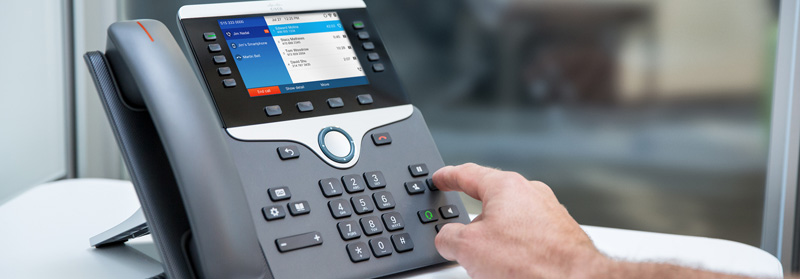[vc_row][vc_column width=”1/1″][vc_column_text disable_pattern=”true” align=”left” margin_bottom=”0″]
The IP phone replaces the copper wire telephone built during the industrial age with an up-to-date communications vehicle for the Internet era.
Think about this: Alexander Graham Bell invented the telephone 140 years ago. His design worked so well that people still use copper wire, analog telephones in their homes. But the office phone has changed, as explained below.
Now think about this: You have probably seen the original Star Trek TV series, even if you are too young to have seen it when it was first broadcast. Way back in the 1960s, Captain Kirk and Spock summoned each other using the original flip phone. They called it the “communicator.” Who watching at that time could have envisioned that today everyone would have a communicator, and that you could buy them for as low as 15 dollars?
But we still have a way to go before we reach Star Trek’s prophecy of the future. We are not yet able to beam into the office; we still have to go there. But the definition of “there” has very much changed. We now work at Starbucks, we work from home, and we work in our cars, even if policemen say we should not.
Today’s worker is no longer tethered to his or her desk like the green-shaded clerks of Mr. Bell’s day. And he or she is no longer limited to voice communications. Now we have video, Skype, WhatsApp, email, voicemail, text messages, and whatever is coming next from Silicon Valley.
So where does that leave us in the modern office?
Enter the IP Phone
Today there is the expectation that you can download Skype or WhatsApp, and that is all you need for communications. People say only crusty old people have landlines. With their sleek iPhones and Samsung Galaxies, Gen Xers would say they don’t even need a landline. That’s true: you don’t need Mr. Bell’s landline telephone anymore. You need something that supports the intersection of inter-office and Internet communications, fixed and mobile devices, and employees and customers who move about. That is what the IP phone does.
So, what is an IP phone?
In short, an IP phone is a desktop phone that replaces the analog copper wire telephone with a digital signal, thus making it an extension of the Internet, office software, and all that these offer.
The name “IP” in the IP phone means Internet Protocol. That’s the same technology that the Internet and your office network uses. But recognizing that the old system still exists, the IP phone also interconnects with the copper wire POTS (plain old telephone system) too. When it hands off calls to carriers it uses protocols like SIP, which is somewhere between an analog phone and a networked one, breathing new life and new possibilities into the old system.
Yet the IP phone does not just change from copper wire to fiber optic cable and from an analog to a digital system. It’s a communication vehicle designed to fit the needs of small to large businesses, whether they are local or far-flung, and a mobile workforce and their mobile devices.
How Is It Different? What Does It Do?
The IP phone communication platform looks like a regular telephone but does so much more. It carries video in addition to audio and connects with the app-economy way of communicating. And it handles instant messaging as well as web and audio conferencing. Not only that, it also works as an extension to the mobile device, handing off calls to the employee’s cell phone.
It works together with tools individuals already use. They can program their workday right into IP phones just like they program their iPads. The data flows back and forth between the two. This lets people work from anywhere, as the phone works as virtual private secretary, providing a virtual presence in the office, regardless of where the person is physically located.
The worker or business owner can program the IP phone from a mobile phone, tablet, laptop, or web page, telling it where to route calls as he or she moves around the office or leaves the office altogether.
The IP phone supports collaboration and office productivity software. It integrates with desktop software like Microsoft Outlook. Click on a phone number and the IP phone connects with that person. There is no need to lift the receiver and dial. That’s the whole point: the phone is on the same network as the office applications and thus is an extension of office productivity tools.
The phone also is cognizant of and works with the repositories where people already store their contacts. The phone taps into contacts stored in Google and Apple clouds in addition to those stored in the corporate Active Directory or LDAP repository. It does all this yet keeps business and personal contacts separate.
Do You Need IP Phones? What’s Required?
An IP phone system is suitable for a small office or a large one. The system can be as simple or as complex as the business desires. Whatever the design, all IP phone systems need a few basic components: a PBX, which is a computer that routes inside the office; a connection to a phone carrier; and a network, which can be your existing office network or one that is engineered to better interconnect the two. And, of course, an IP phone network requires IP phones, as the regular home phone will not work there.
Regarding setting all this up, a company could install all of that themselves, hire a networking and communications firm, or host all of that in the cloud. The cloud, of course, has become the de facto operating model for computing in general because of its lowest TCO (total cost of ownership), simplicity, security, and reliability. So it makes sense for those looking to get online quickly and with the least complication and cost.
So that’s a basic overview of what the IP phone is and how it helps businesses bring together the Internet and the office.
[/vc_column_text][/vc_column][/vc_row][vc_row][vc_column][mk_custom_box bg_color=”#f6f6f6″ bg_position=”left top” bg_repeat=”repeat” bg_stretch=”false” padding_vertical=”30″ padding_horizental=”20″ margin_bottom=”10″ min_height=”100″][vc_column_text disable_pattern=”true” align=”left” margin_bottom=”0″]
